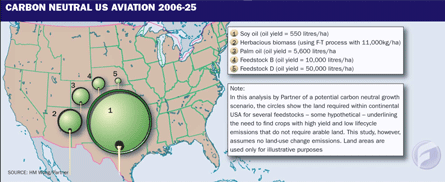One US research effort that is set to provide the basis for much of the future policy framework for alternative fuel in commercial air transport is Project 17 of the Partnership for AiR Transportation Noise and Emission Reduction.
Partner is a multi-university aviation research organisation headquartered at Massachusetts Institute of Technology and Project 17 was set the task of examining the potential near-term alternative jet fuels.
Funded by the Federal Aviation Administration, the Project 17 team has conducted a painstaking and all-important lifecycle analysis of candidate fuels that importantly adopts a well-to-wake lifecycle analysis for alternative jet fuels
In this way it has managed to establish vital common ground as the industry goes deeper in its research to find ways of reducing aviation's climate footprint.
 |
|---|
Click on graphic to see larger version |
James Hileman, reporting late last year on the progress of his Massachusetts Institute of Technology team at the Omega international conference on alternative aviation fuels in London, told delegates that the goal had been ambitious from the outset.
The team was tasked with examining the environmental impacts from all fuel substitute options, particularly on those that would improve environmental performance.
It then went on to develop an aviation-specific analysis framework that could build in a whole set of variables - focused on those fuel substitutes that would be compatible in existing aircraft and that have a consistently measurable impact on climate change, air quality and reliable production potential - all within a 10-year timeframe.
"That really represented what was groundbreaking about the study - trying to compare a wide variety of things as opposed to thinking just about emissions," says Hileman.
All fuels were examined not only for their "well-to-wake" benefits but also "tank-to-wake" qualities in a range of aircraft from regional jets to the Airbus A380. Here, great efforts went into analysing energy density and its impact on aircraft range and payload capacity as well as the compositional focus on particulates and their effect on local air quality.
In terms of further work on quantifying well-to-wake benefits, Partner researchers have narrowed down their search, and will examine in detail several fuel pathways under sister Project 28 including a combination of a coal and biomass feedstock using a Fischer-Tropsch processing technique with and without carbon capture to produce a synthetic paraffinic kerosene (SPK).
The team will also study biomass cultivation and extraction of plant oils from algae and jatropha feedstocks using a hydroprocessing technique to produce another sort of SPK fuel termed a hydroprocessed renewable jet.
This environmental cost-benefit analysis by the joint US Air Force Research Laboratory and FAA will use measurement and modelling and is to report in August 2010.
 |
|---|
Click on graphic to see larger version |
Within the analysis framework, the research team also built in an assessment of the question marks which still hang over issues relating to feedstock properties, nitrous oxide emissions from fertiliser use, land use change emissions, process efficiencies.
The study which involved the collaboration of many other research organisations looks likely to settle on a few choice conclusions that have emerged from the findings.
Coal-to-liquid fuels using the Fischer-Tropsch process with the controversial option of carbon capture and storage (CCS) deep underground have comparable lifecycle carbon emissions to conventional fuel and their use could improve air quality. Without CCS, however, lifecycle carbon emissions could double or even triple with low efficiency and poor quality coal.
"The issue here principally is that society creates vast quantities of CO2 and it has to deal with that. CCS is complex and not without its safety implications, but it is not insurmountable. It is already a technique that is used in oil recovery, so it's just a question of proving it works at larger scales at affordable costs," says Hileman.
Alternative fuels do exist that could both reduce lifecycle CO2 and improve air quality such as biojet and biomass-to-liquids using the Fischer-Tropsch process. It is the limited ability to produce these fuels that is the problem, difficulties with developing feedstocks with sufficiently high yield and low lifecycle emissions which have no impact on arable land.
"Here it's a matter of what is the impact on your food supply, what sort of land are you using and what is the biomass yield. Algae has been talked about a lot, but you have to examine the processing technique involved as there is a high variation between using a bioreactor or using open ponds," says Hileman.
While it plans to extend its scope to include a wider range of fuel pathways with longer time horizons and examine the potential for carbon-neutral growth and even a zero-carbon future, the issue remains one of scale. "It's one thing to make enough fuel to power a single flight or a single airport, but it's quite another to fuel the US or global fleet. That's a very different proposition," Hileman says.
Source: Flight International
















